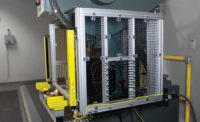Insurance studies indicate machine safeguarding provides an excellent opportunity for businesses to reduce bottom-line operating costs by eliminating both the direct and indirect costs of employee accidents.
Consider this: According to the 2018 Liberty Mutual Workplace Safety Index, serious, non-fatal workplace injuries amounted to nearly $60 billion in direct U.S. worker’s compensation costs. This translates into more than one billion dollars a week spent by businesses on injuries. Another study conducted by Colorado State University set the total direct and indirect cost of workplace injuries at $128 billion. For its part, the National Safety Council (NSC) set the total cost to society of occupational injuries and deaths at $151.1 billion.
Direct costs
First off, what are the direct costs of an accident? These refer to out-of-pocket expenses like hospital and medical bills, workers’ compensation payments, and higher insurance premiums.
The NSC estimates that cost per medically consulted injury, counting wage losses, medical expenses, administrative expenses and other direct employer costs, to be $32,000. This varies greatly by the injury’s cause and nature, and which part of the body is impacted. For example, the average cost per worker compensation claim involving an amputation runs $95,204, while a crushing accident is $57,519. These two sorts of injuries are mentioned here because they are both common outcomes in machinery-related accidents. The NSC also reports that an employee death resulting from an accident costs the company on average $1.2 million. Total medical cost to society annually from occupational injuries and deaths is $33.8 billion.
Indirect costs
Analysis reveals that the actual total cost of an accident can range from four to ten times the direct cost stated by an insurance company once indirect costs are factored in. Indirect costs can include such things as workplace disruptions, loss of productivity, brand denigration, and even loss of insurability. There is the loss of a worker's time because of the accident, the lost productivity by the machine involved in the accident being idled or requiring repairs, as well as the other machines further down the production line being shut down. And of course, there is litigation. Lawsuits resulting from employee injuries or death, especially those involving a lack of machine safeguarding, often result in multi-million dollar settlements or verdicts. As a result, cash targeted for company growth may need to be diverted to cover legal costs, putting the future of the company itself in jeopardy.
Finally, a poor safety record can make the difference between a company winning or losing bids, especially with government contracts. A plant with a singularly bad reputation for safety may also find itself unable to attract qualified workers or may have to pay wages well above market value to do so. Also, if the machine is locked out for investigation or until the safeguarding deficiency is abated, the company may need to outsource the work at a much higher cost. It’s also possible that the work is so specialized that it’s impossible to outsource and therefore the company loses the business.
Management opinions on safety
A poll by Liberty Mutual Group insurance showed that the majority of executives surveyed (61%) reported that for every one dollar spent on safety, three dollars is saved. Nearly all (95%) said workplace safety had a positive effect on financial performance. OSHA estimates a 6:1 ratio for saved dollars for every one dollar invested in safety, twice Liberty Mutual's 3:1 ratio.
Of course, if a company could be guaranteed a huge return on their safety investment, more than half the machines in the United States today would not be operating unprotected. Convincing upper management to commit tens of thousands of dollars on machine safeguarding when a return may not be seen for years can be a hard sell. In this situation, safety professionals should stress that although cost savings are a motivator, safety’s biggest ROI comes in the form of human capital. Money savings from fewer injuries, increased productivity, and higher morale are all additional benefits.
First step to improved safety: risk assessment
All of this leads to the obvious question of “How do we get started?.” The answer is a risk assessment of your current manufacturing operations.
Machine Risk Assessments are typically based on ANSI B11.0-2015 (Safety of Machinery – General Requirements and Risk Assessment), the industry standard for machine safeguarding. Your risk assessment must be conducted by a trained and certified safety engineer or risk assessor who has a thorough understanding of the ANSI risk assessment and risk reduction process, as well as practical know-how into implementing machine safeguarding programs and what additional services may be necessary to support such a project.
Upon arriving at your site the safety engineer will:
- Collect and review your facility’s accident history
- Identify every hazardous machine motion or harmful condition where a worker’s body part is exposed
- Calculate risk scoring on a sliding scale using the ANSI B11.0-2015 safety standard method which quantifies the severity and likelihood of an injury
- Determine if further safeguarding methods should be applied to machines or processes to minimize risk to a tolerable level
- Provide comprehensive documentation to share with OSHA inspectors that outlines survey results.
Machine dangers sometimes present themselves through accidents and near misses. More often than not, however, they lurk in the darkness on machines thought to be “low” risk. Employers naturally address high-risk machines during machine assessments, and then move down the line, often overlooking everyday machines such as grinders. The fact is if it rotates, slides, reciprocates, turns, presses or cuts, the machine is not safe. If machine parts can rupture or explode, such as an abrasive wheel, it is dangerous and needs to be surveyed, as well. Another factor in lack of compliance is the machine manufacturer itself. OSHA and ANSI require safety equipment and proper machine controls, yet many manufacturers sell machinery without either, leaving the customer with the responsibility of safeguarding the machine. Some customers make the mistake of thinking that new machines arrive fully safeguarded according to the latest compliance standards. For those reasons and others, risk assessments should be performed on all machines on the plant floor before implementing the risk reduction portion of the plan.
One accident, two outcomes
Let’s consider a scenario of two identical metal fabricating shops. Both use the same types of machinery operated by professionals with the same level of skills. The products being manufactured are similar, as well. In fact, the only difference is that Shop #1 conducted a machine assessment that identified safety issues that management immediately addressed with required guarding, while Shop #2 did not and had an employee loss a hand in a press brake accident when he reached into the operating area to clean the die.
To calculate the cost of the accident at Shop #2 we use OSHA’s $afety Pays estimator available at www.osha.gov/dcsp/smallbusiness/safetypays/estimator.html. While only aimed at raising employers’ awareness of the financial impact of occupational injuries, OSHA $afety Pays does not pull its numbers out of the sky. It uses average claim cost estimates provided by National Council on Compensation Insurance, Inc. (NCCI). The data reflects the average cost of lost time workers' compensation insurance claims derived from unit statistical reports submitted to NCCI for policy years 2013-2015.
According to OSHA’s calculations and assuming Shop #2 has a 15% profit margin on its operations, an amputation injury will typically require direct costs of $88,991 and indirect costs of $97,890, totally $186,881. OSHA $afety Pays takes into consideration the additional sales required to make up for the expense; in this instance, at a profit margin of 15%, the shop will need to generate an additional $1,245,873 simply to breakeven.
Meanwhile, at Shop #1 the same press brake accident doesn’t occur. Management had the foresight to install perimeter guarding, a light curtain system, an e-stop assembly and other required equipment to achieve compliance. In this case when the operator attempted to reach into the press to change a die, the machine shut down, preventing an employee accident and any disruptions to production. Total cost for safeguarding such a machine is estimated to be $ 8,500 or approximately $170,000 less than the cost to Shop #2 for not safeguarding it. Moreover, the safeguarding will continue to prevent accidents as long as the press brake is in operation.
Final thoughts
Often times, companies view machine safeguarding only as an expense and fail to see it for what it is: an investment delivering a quantifiable, real-world ROI. By comparing the installation cost of machine safeguarding over the productive life of a machine versus the direct and indirect costs of even a single accident, the financial benefits make good business (and humanistic) sense.







